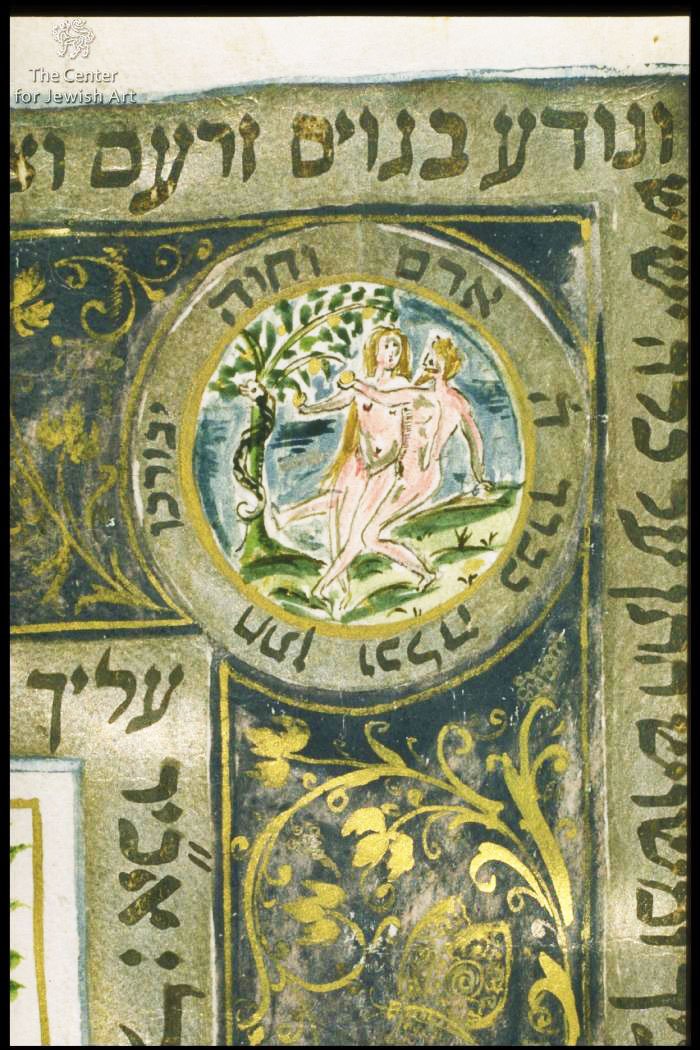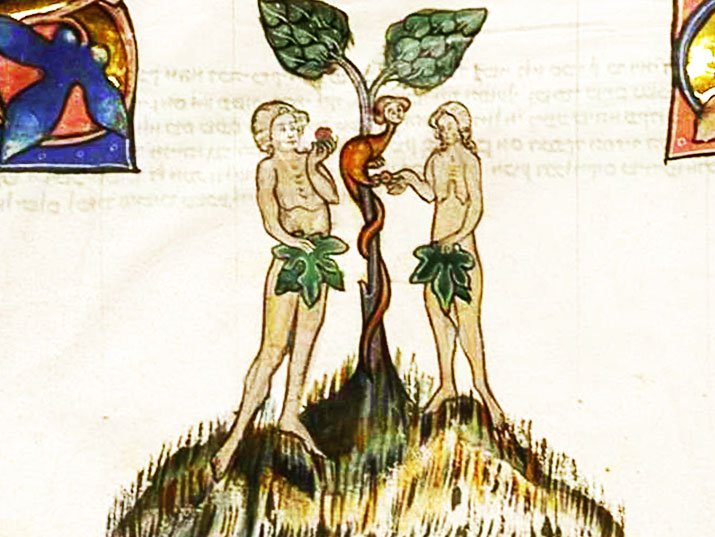Was Adam Created Androgynous? A Textual and Traditional Refutation

Image Source: A Peek into Paradise: What Can Medieval Manuscripts Teach Us about Adam and Eve? https://share.google/WO2kYWxHfJHHzWN7P
The idea that Adam, the first human in the Torah, was created as an androgynous or dual-sex being—containing both male and female aspects—appears in certain Jewish mystical traditions. This interpretation suggests that Adam (הָאָדָם, ha-adam) was originally a unified entity, split into male and female when Eve was created. While intriguing, this view is conjectural and lacks support in the plain reading (peshat) of the biblical text. In this post, I’ll explore the androgynous Adam theory, its basis in Jewish tradition, and why it is unconvincing when weighed against the Torah’s text, particularly the Hebrew term צֵלָע (tsela), and authoritative Jewish commentators.
The Androgynous Adam Theory: Its Roots and Purpose
The notion of an androgynous Adam stems from interpretations of Genesis 1:27 (בְּרֵאשִׁית א:כז), which states: “וַיִּבְרָא אֱלֹהִים אֶת־הָאָדָם בְּצַלְמוֹ בְּצֶלֶם אֱלֹהִים בָּרָא אֹתוֹ זָכָר וּנְקֵבָה בָּרָא אֹתָם” (“So God created man in His own image, in the image of God He created him; male and female He created them”). Some scholars, particularly in mystical circles, argue that the phrase “זָכָר וּנְקֵבָה” (“male and female”) and the plural “אֹתָם” (otam, “them”) imply Adam was a single being encompassing both genders before Eve’s creation in Genesis 2:21-22 (בְּרֵאשִׁית ב:כא-כב).
This view appears in several sources:
- Midrash Rabbah (Bereshit Rabbah 8:1): Rabbi Jeremiah ben Eleazar suggests Adam was created with “two faces” (du-partzufin), interpreted by some as a dual-sex being, male and female conjoined, later separated into Adam and Eve.
- Talmud (Berakhot 61a, Eruvin 18a): These passages discuss Adam’s dual nature, implying a physical or symbolic unity of male and female before Eve’s creation.
- Zohar (I:34b): This Kabbalistic text describes Adam as an androgynous figure reflecting divine unity, with Eve’s creation symbolizing the separation of feminine and masculine aspects to enable human partnership.
The purpose of this interpretation is theological and symbolic. It portrays humanity, created in God’s image (בְּצֶלֶם אֱלֹהִים, b’tselem Elohim), as encompassing both genders, reflecting divine wholeness. In Kabbalah, the separation of Eve and her reunification with Adam in marriage symbolize cosmic harmony and restoration (tikkun). The theory also seeks to reconcile Genesis 1’s simultaneous creation of “male and female” with Genesis 2’s sequential narrative, where Eve is formed from Adam’s “side” (צֵלָע, tsela).
While these ideas are thought-provoking, they rely on speculative and allegorical readings, not the plain text of the Torah. Let’s examine why the androgynous Adam theory doesn’t hold up under scrutiny.
Refuting the Androgynous Adam: The Biblical Text
The Torah’s account in Genesis 2 (בְּרֵאשִׁית ב) provides a clear narrative that undermines the idea of an androgynous Adam. Here are the key textual points, with relevant Hebrew terms:
Genesis 2:7 – Adam as a Singular Male: The verse states, “וַיִּצֶר יְהוָה אֱלֹהִים אֶת־הָאָדָם עָפָר מִן־הָאֲדָמָה וַיִּפַּח בְּאַפָּיו נִשְׁמַת חַיִּים וַיְהִי הָאָדָם לְנֶפֶשׁ חַיָּה” (“And the Lord God formed man of the dust of the ground, and breathed into his nostrils the breath of life; and man became a living soul”). The Hebrew הָאָדָם (ha-adam) refers to a singular human, consistently described with masculine pronouns (הוּא, hu, “he”). There is no hint of a dual-sex nature in this initial creation.
Genesis 2:18 – Adam’s Solitude: God declares, “לֹא־טוֹב הֱיוֹת הָאָדָם לְבַדּוֹ אֶעֱשֶׂה־לּוֹ עֵזֶר כְּנֶגְדּוֹ” (“It is not good for the man to be alone; I will make him a helper suitable for him”). This statement implies Adam was a solitary male needing a partner, not a being containing both genders. If Adam were androgynous, his “aloneness” (לְבַדּוֹ, l’vado) would be nonsensical, as he would already encompass both male and female aspects.
Genesis 2:21-22 – Eve’s Creation from צֵלָע (Tsela): The text states, “וַיִּקַּח אֶחָד מִצַּלְעֹתָיו וַיִּסְגֹּר בָּשָׂר תַּחְתֶּנָּה... וַיִּבֶן יְהוָה אֱלֹהִים אֶת־הַצֵּלָע אֲשֶׁר־לָקַח מִן־הָאָדָם לְאִשָּׁה” (“And He took one of his ribs/sides, and closed up the flesh in its place... And the Lord God built the tsela that He had taken from the man into a woman”). In biblical Hebrew, צֵלָע (tsela) typically means “side” (e.g., Exodus 26:20, שְׁלוֹשָׁה צְלָעוֹת, “three sides” of the Tabernáculo) but is often translated as “rib.” The verbs “took” (וַיִּקַּח, vayyikach) and “closed up” (וַיִּסְגֹּר, vayyisgor) suggest a physical extraction from Adam’s male body, not the separation of a pre-existing female half. Eve is created as a distinct entity, not derived from an androgynous whole.
Genesis 2:23 – Adam’s Recognition of Eve: Adam declares, “זֹאת הַפַּעַם עֶצֶם מֵעֲצָמַי וּבָשָׂר מִבְּשָׂרִי לְזֹאת יִקָּרֵא אִשָּׁה כִּי מֵאִישׁ לֻקְּחָה־זֹאת” (“This is now bone of my bones and flesh of my flesh; she shall be called Woman [ishah], because she was taken out of Man [ish]”). This emphasizes Eve’s derivation from Adam’s body, reinforcing their distinct identities as male (אִישׁ, ish) and female (אִשָּׁה, ishah), not a division of a dual-sex being.
Genesis 1:27’s phrase “זָכָר וּנְקֵבָה בָּרָא אֹתָם” (“male and female He created them”) does not necessitate an androgynous Adam. As a broad overview of creation, Genesis 1 describes humanity (הָאָדָם, ha-adam) collectively, with the plural “אֹתָם” (otam, “them”) referring to humankind’s potential for both genders, not a single dual-sex individual. Genesis 2 zooms in on the specific process, clarifying that Adam was male, and Eve was created later.
Traditional Jewish Sources Against the Androgynous View
Authoritative Jewish commentators, prioritizing the peshat (plain meaning), consistently depict Adam as a male individual, with Eve formed as a separate female. Key sources include:
- Rashi (Commentary on Genesis 2:21): Rashi interprets צֵלָע (tsela) as “rib” and describes Eve’s creation as a distinct act, with no suggestion of an androgynous Adam. He emphasizes the physical extraction from Adam’s male body.
- Maimonides (Guide for the Perplexed, Part I, Chapter 17): Maimonides treats Adam as a singular male created in God’s image (בְּצֶלֶם אֱלֹהִים, b’tselem Elohim), focusing on his intellectual and spiritual capacities, with Eve as a subsequent creation.
- Ibn Ezra (Commentary on Genesis 2:21): Ibn Ezra interprets צֵלָע (tsela) as a rib, rejecting speculative readings and affirming Eve’s creation as a separate act from Adam’s male body.
- Targum Onkelos (Genesis 2:21): This Aramaic translation renders צֵלָע (tsela) as “rib” (עִלְעָא, il’a) and presents Eve’s creation as distinct, with no hint of an androgynous original state.
These sources align with the peshat, avoiding the mystical speculation of midrashic and Kabbalistic texts.
Weaknesses of the Androgynous Interpretation
The androgynous Adam theory, while symbolically rich, has several flaws:
- Textual Ambiguity: Genesis 1:27’s “זָכָר וּנְקֵבָה בָּרָא אֹתָם” (“male and female He created them”) refers to humanity as a whole, not a single androgynous being. The plural “אֹתָם” (otam) aligns with the creation of humankind, not an individual with dual genders.
- Midrashic Speculation: Texts like Bereshit Rabbah (8:1) and the Talmud (Berakhot 61a, Eruvin 18a) are homiletic, exploring theological possibilities rather than establishing literal truth. They compete with other rabbinic views that see Adam as male.
- Kabbalistic Context: The Zohar’s androgynous Adam is a later, esoteric interpretation (13th century), prioritizing symbolism over the peshat. It lacks the authority of earlier, text-focused commentators.
- Narrative Incoherence: If Adam were androgynous, Genesis 2:18’s emphasis on his solitude (לְבַדּוֹ, l’vado) and need for a “helper” (עֵזֶר כְּנֶגְדּוֹ, ezer kenegdo) would be illogical, as he would already contain both genders.
- Lack of Explicit Support: The Torah never describes Adam as dual-sex or dual-faced. The androgynous view requires reading assumptions into the text, unlike the straightforward narrative of Genesis 2.
Conclusion
The androgynous Adam interpretation, found in some midrashic and Kabbalistic traditions, offers a fascinating theological perspective on human unity and divine harmony. However, it lacks grounding in the plain text of the Torah and is not supported by authoritative commentators like Rashi, Maimonides, and Ibn Ezra. Genesis 2 (בְּרֵאשִׁית ב) clearly presents Adam (הָאָדָם, ha-adam) as a male individual, with Eve created as a distinct female from his צֵלָע (tsela) to address his solitude. The androgynous view relies on speculative readings that prioritize symbolism over the peshat, making it a weaker interpretation. For those seeking the Torah’s intended meaning, the textual evidence and traditional exegesis affirm a straightforward account of male and female creation as separate, complementary acts.
References:
- Torah: Genesis 1:27 (בְּרֵאשִׁית א:כז), 2:7, 2:18-23 (בְּרֵאשִׁית ב:ז, יח-כג); Exodus 26:20 (שְׁמוֹת כו:כ).
- Midrash: Bereshit Rabbah 8:1.
- Talmud: Berakhot 61a, Eruvin 18a.
- Zohar: I:34b.
- Rashi: Commentary on Genesis 2:21 (בְּרֵאשִׁית ב:כא).
- Maimonides: Guide for the Perplexed, Part I, Chapter 17.
- Ibn Ezra: Commentary on Genesis 2:21 (בְּרֵאשִׁית ב:כא).
- Targum Onkelos: Genesis 2:21 (בְּרֵאשִׁית ב:כא).

Image Source: A Peek into Paradise: What Can Medieval Manuscripts Teach Us about Adam and Eve? https://share.google/WO2kYWxHfJHHzWN7P